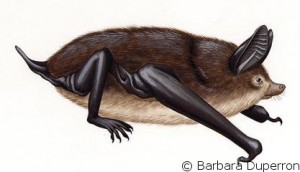
The New Zealand greater short-tailed bat (Mystacina robusta) has been described as ‘the bat family’s attempt to produce a mouse’, due to their unique ability to scramble over the ground as well as fly. This bat is one of only two species in the family Mystacinidae, part of the Noctilionoidea ‘superfamily’. Until recently, its sister species, the lesser short-tailed bat (M. tuberculata) was believed to be the sole survivor of the Mystacina. These two species of bat have no other close relatives anywhere in the world.
The greater short-tailed bat is New Zealand’s largest bat, but still quite small by world bat standards, 90mm in length with a wing span of 300mm, and uniquely among bats, they have extra thumb and toe talons. Greater short-tailed bats are extremely agile on the ground, smelling out prey amongst leaf litter, and tucking their wings away when running along the ground which allows them to use their arms as legs. When flying they use echolocation to find prey, but seldom fly higher than three metres because of the risk of clashing with bird colonies. Evidence suggests that females only have one offspring per year, a very low reproductive rate which is likely to be a reason why they are critically endangered.
Very little is known about the habitat preferences of this species, but the lesser short-tailed bat is restricted to pristine old-growth forest and it is likely that the greater short-tailed bat is too. Remains of the greater short-tailed bat have been found in limestone caves, suggesting that it roosted in caves, and possibly in tree cavities as well. This bat is endemic to New Zealand, and fossils show that it once lived in both the North and South Islands, but the species disappeared from these regions following European colonisation 200 years ago. Greater short-tailed bats were present on Big South Cape and Solomon Islands until the early 1960s when ship rats (Rattus exulans) were accidentally introduced, which would have predated heavily on terrestrial bat species.
The only photo of this bat that exists was taken by Don Merton in 1965 at Puwai Bay, Big South Cape Island, and the last confirmed sighting of the greater short-tailed bat was in 1967 at the same location. Nothing was heard of it again until unconfirmed reports in 1999 of brief sightings and Mystacina-like echolocation calls that could not be attributed to the lesser short-tailed bats. The species may still exist in tiny fragmented populations, but it is possible that as there is probably less than 50 mature individuals the greater short-tailed bat may be doomed to extinction.
Help EDGE to pull back species from extinction: in the case of animals like the greater short-tailed bat, we are racing against the clock…